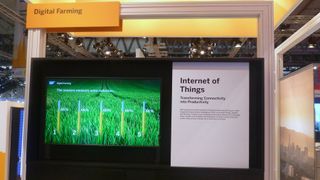How the IoT is creating 'precision farming'
Agribusiness is being digitised by IoT sensors and the cloud
Autonomous planters
Monitoring how crops are doing, and what they need, is one thing, but what about the actual planting? That's also being streamlined as farms get networked. Using GPS, John Deere already sells automated planters that can run at 10mph and autonomously plant 24 rows of seeds to a depth of exactly 1.5-inches, and plant them 3-inches apart. All the farmer does is use the SeedStar app on an iPad, where real-time readouts of the planters' progress are viewable.

Productivity priorities
With planters able to take measurements and transmit data, the key ingredient in smart farming becomes the SaaS platform. Business application software company SAP has developed SAP Vehicle Insights, which collates all the data collected on the farm and introduces unstructured data, such as weather information and imaging from satellites.
"It makes big data into smart data," says Matthias Aurin, SAP software development architect at SAP SE (smart farms). "It integrates all the data available – from sensors and connected machines, external weather information, satellite images, information from drones, and past growing information – and transforms it into valuable business data to help the farmer prioritise."
Resource billing
For instance, the system can identify which fields need irrigation, but if there's rain predicted, it informs the farmer. "Farmers can measure the profitability of fields, and see why some fields are more profitable than others," says Aurin. "You can reduce the amount of fertiliser according to exactly what's needed."
The SAP system can also show the availability of a farmer's favoured sub-contractors, but the fleet management part of the system helps them, too. Since it collects telematics data from connected vehicles – on speed, fuel consumption, and exactly what they're doing – a contractor can see precisely how much fertiliser and fuel is being used, enabling resource-related billing.

An Internet of Food?
Most of this tech is aimed at producing greater amounts of food more cheaply. "Increased yields at the farm level through other Internet of Things applications – such as soil moisture monitoring, weather pattern analytics, and the use of drones – should also increase the supply of food," says Isabel Chapman, Principal Analyst at Machina Research.
But Internet of Things applications are also being used to streamline the 'cold chain' in an effort to make imported, globally-traded foodstuffs – such as prawns, and vegetables that spoil quickly – more reliable. By fitting a SIM card to a refrigerated container, the owner can view its location and see a digital audit trail of any delays or breakdowns. It's much like a black box recorder on a plane.
Are you a pro? Subscribe to our newsletter
Sign up to the TechRadar Pro newsletter to get all the top news, opinion, features and guidance your business needs to succeed!
"IoT applications provide real-time audit trails, notifications, and monitoring of shipments from producer to retailer," says Chapman. "Each partner in the chain can have access to all information as the shipment is in transit."
From networked farms and climate sensors to activity trackers and drones, the IoT, big data and the cloud is quickly finding fertile ground.
- Also check out: Cloud on clouds: How weather data is a test-bed for new tech
Image Credits: Fujitsu, PrecisionHawk, Jamie Carter
Jamie is a freelance tech, travel and space journalist based in the UK. He’s been writing regularly for Techradar since it was launched in 2008 and also writes regularly for Forbes, The Telegraph, the South China Morning Post, Sky & Telescope and the Sky At Night magazine as well as other Future titles T3, Digital Camera World, All About Space and Space.com. He also edits two of his own websites, TravGear.com and WhenIsTheNextEclipse.com that reflect his obsession with travel gear and solar eclipse travel. He is the author of A Stargazing Program For Beginners (Springer, 2015),

